

14 Best Online Bibliography and Citation Tools. K - 2. How to Cite a Site (3-5) Citing - for the Very Young (Super3 style) - Big6. Citing and Crediting - Super3 Style I've been thinking a lot about developing citing /creditng skills among elementary students.
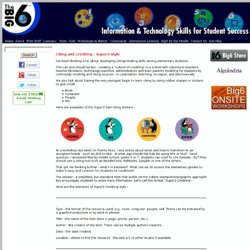
This can and should be fun - creating a "culture of crediting" in a school with classroom teachers, teacher - librarians, technology teachers, administrators and even parents modeling for students by continually crediting and citing sources - in coversation, teaching, on paper, and electronically. We also talk about having the very young est begin to learn citing by using rubber stamps or stickers to give credit - Book Computer People Me.
Here are examples of the Super3 Sam citing stickers - At a workshop last week (in Puerto Rico), I was asked about when and how to transition to an accepted for mat - such as APA or MLA. That got me thinking fur the r - what's in between? The answer - a simplified, but standard style that builds on the rubber stamp/sticker/graphic approach but encourages students to enter more in for mation. Author - the creator of the item. Copyright, Fair Use and Research Skills for Elementary Students. Research Building Blocks: “Cite Those Sources!” ReadWriteThink couldn't publish all of this great content without literacy experts to write and review for us.
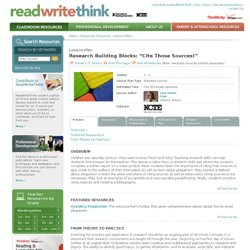
If you've got lessons plans, activities, or other ideas you'd like to contribute, we'd love to hear from you. More Find the latest in professional publications, learn new techniques and strategies, and find out how you can connect with other literacy professionals. Teacher Resources by Grade Your students can save their work with Student Interactives. More Home › Classroom Resources › Lesson Plans Lesson Plan Overview Featured Resources. Learning Resources: Citing Internet Resources. Is it okay to copy information such as words and pictures from the Internet?
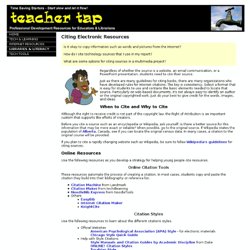
How do I cite technology sources that I use in my report? What are some options for citing sources in a multimedia project? Regardless of whether the source is a website, an email communication, or a PowerPoint presentation, students need to cite their source. Just as there are many guidelines for citing books, there are many organizations who have developed rules for Internet citations. The key is consistency. When to Cite and Why to Cite Although the right to receive credit is not part of the copyright law, the Right of Attribution is an important custom that supports the efforts of creators. Before you cite a source such as an encyclopedia or Wikipedia, ask yourself: is there a better source for this information that may be more exact or reliable? If you plan to cite a rapidly changing website such as Wikipedia, be sure to follow Wikipedia's guidelines for citing sources. Online Resources Online Citation Tools. The View From Here - Citations for Elementary Students. My 4th and 5th grade teachers have been collaborating with me over the last two months to plan research projects for their students, and to my great surprise our biggest sticking point has been what citation format to use!
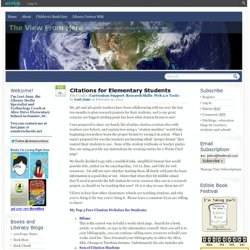
I was prepared to share my handy list of online citation creation sites with teachers (see below), and explain how using a “citation machine” would help beginning researchers learn the proper format by seeing it in action. What I wasn’t prepared for was the teachers not knowing which “proper format” they wanted their students to use. None of the student textbooks or teacher guides they are using provide any instructions for creating entries for a Works Cited page! We finally decided to go with a modified (aka, simplified) format that would provide title, author (or for encyclopedias, Vol #), date, and URL for web resources. I’m still not sure whether starting them off slowly with just the basic information is a good idea or not. Doing Internet Research at the Elementary Level.
One of the hardest things to teach, in my opinion, is research.
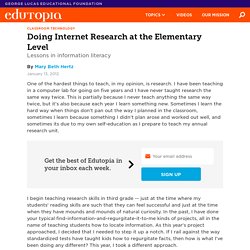
I have been teaching in a computer lab for going on five years and I have never taught research the same way twice. This is partially because I never teach anything the same way twice, but it's also because each year I learn something new. Sometimes I learn the hard way when things don't pan out the way I planned in the classroom, sometimes I learn because something I didn't plan arose and worked out well, and sometimes its due to my own self-education as I prepare to teach my annual research unit. I begin teaching research skills in third grade -- just at the time where my students' reading skills are such that they can feel successful and just at the time when they have mounds and mounds of natural curiosity. In the past, I have done your typical find-information-and-regurgitate-it-to-me kinds of projects, all in the name of teaching students how to locate information.
Choosing a Topic, Creating Keywords and Search Terms.